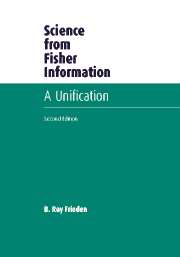Book contents
- Frontmatter
- Contents
- 0 Introduction
- 1 What is Fisher information?
- 2 Fisher information in a vector world
- 3 Extreme physical information
- 4 Derivation of relativistic quantum mechanics
- 5 Classical electrodynamics
- 6 The Einstein field equation of general relativity
- 7 Classical statistical physics
- 8 Power spectral 1 / ƒ noise
- 9 Physical constants and the 1/x probability law
- 10 Constrained-likelihood quantum measurement theory
- 11 Research topics
- 12 EPI and entangled realities: the EPR–Bohm experiment
- 13 Econophysics, with Raymond J. Hawkins
- 14 Growth and transport processes
- 15 Cancer growth, with Robert A. Gatenby
- 16 Summing up
- Appendix A Solutions common to entropy and Fisher I-extremization
- Appendix B Cramer–Rao inequalities for vector data
- Appendix C Cramer–Rao inequality for an imaginary parameter
- Appendix D EPI derivations of Schrödinger wave equation, Newtonian mechanics, and classical virial theorem
- Appendix E Factorization of the Klein–Gordon information
- Appendix F Evaluation of certain integrals
- Appendix G Schrödinger wave equation as a non-relativistic limit
- Appendix H Non-uniqueness of potential A for finite boundaries
- Appendix I Four-dimensional normalization
- Appendix J Transfer matrix method
- Appendix K Numerov method
- References
- Index
2 - Fisher information in a vector world
Published online by Cambridge University Press: 03 February 2010
- Frontmatter
- Contents
- 0 Introduction
- 1 What is Fisher information?
- 2 Fisher information in a vector world
- 3 Extreme physical information
- 4 Derivation of relativistic quantum mechanics
- 5 Classical electrodynamics
- 6 The Einstein field equation of general relativity
- 7 Classical statistical physics
- 8 Power spectral 1 / ƒ noise
- 9 Physical constants and the 1/x probability law
- 10 Constrained-likelihood quantum measurement theory
- 11 Research topics
- 12 EPI and entangled realities: the EPR–Bohm experiment
- 13 Econophysics, with Raymond J. Hawkins
- 14 Growth and transport processes
- 15 Cancer growth, with Robert A. Gatenby
- 16 Summing up
- Appendix A Solutions common to entropy and Fisher I-extremization
- Appendix B Cramer–Rao inequalities for vector data
- Appendix C Cramer–Rao inequality for an imaginary parameter
- Appendix D EPI derivations of Schrödinger wave equation, Newtonian mechanics, and classical virial theorem
- Appendix E Factorization of the Klein–Gordon information
- Appendix F Evaluation of certain integrals
- Appendix G Schrödinger wave equation as a non-relativistic limit
- Appendix H Non-uniqueness of potential A for finite boundaries
- Appendix I Four-dimensional normalization
- Appendix J Transfer matrix method
- Appendix K Numerov method
- References
- Index
Summary
Classical measurement of four-vectors
In the preceding chapter, we found that the accuracy in an estimate of a single parameter θ is determined by an information I that has some useful physical properties. It provides new definitions of disorder, time, and temperature, and a variational approach to finding a single-component PDF law p(x) of a single variable x. However, many physical phenomena are describable only by multiple- component PDFs, as in quantum mechanics, and for vector variables x, since worldviews are usually four-dimensional (as required by covariance). Our aim in this chapter, then, is to form a new, scalar information I that is appropriate to this multi-component, vector scenario. The information should be intrinsic to the phenomenon under measurement and not depend, e.g., upon exterior effects such as the noise of the measuring device.
The “intrinsic” measurement scenario
In Bayesian statistics, a prior scenario is often used to define an otherwise unknown prior probability law; see, e.g., Good (1976), Jaynes (1985), or Frieden (2001). This is a model scenario that permits the prior probability law to be computed on the basis of some ideal conditions, such as independence of data, and/or ‘maximum ignorance’ (see below), etc. We will use the concept of the prior scenario to define our unknown information expression.
For this purpose we proceed to analyze a particular prior scenario. This is an ideal, 4N-dimensional measurement scenario – the vector counterpart of the scalar parameter problem of Sec. 1.2.1.
- Type
- Chapter
- Information
- Science from Fisher InformationA Unification, pp. 58 - 73Publisher: Cambridge University PressPrint publication year: 2004



